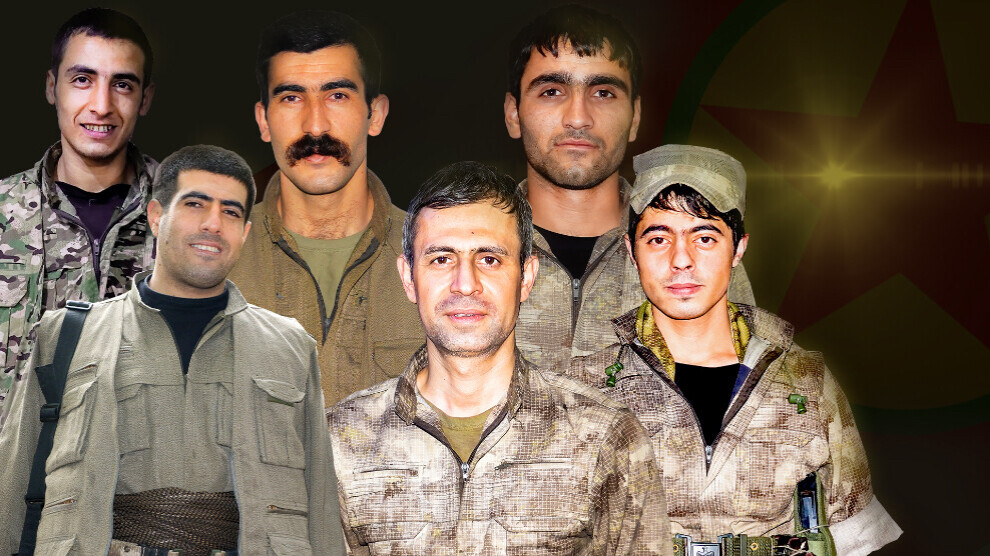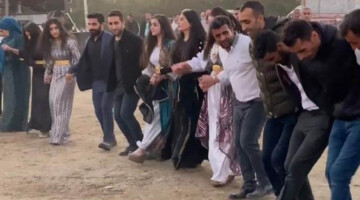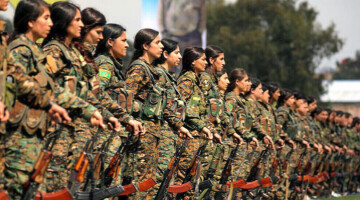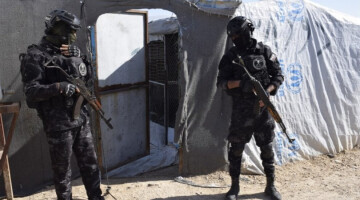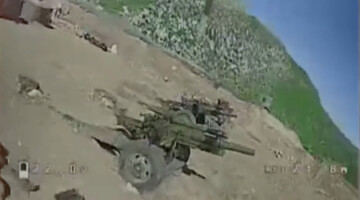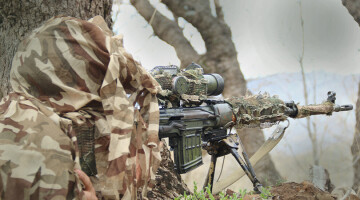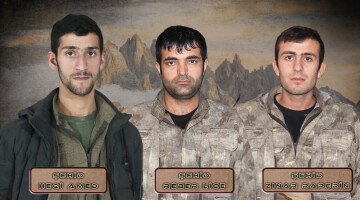A historic resistance is taking place in the war tunnels in the Şehîd Munzur area in Zap region. This resistance has left three years behind. The occupying Turkish army tried to break this resistance by using all its means with all kinds of attacks and banned weapons, it ended up fruitless and helpless against the guerrillas because these valiant, selfless and courageous guerrillas, the defenders of the mountains of Kurdistan, are heroes like Gabar Botan, Xebat Tîrêj, Şervan Guerrilla, Çiyager Dîcle, Erdal Reşo and Munzur Serhed who sacrificed their lives for the sake of victory. That is why the resistance positions in the mountains of Kurdistan will never fall and the spirit of resistance will never disappear. The books of Kurdish and Kurdistan history are written with epics of resistance, because the Kurdish people have always managed to preserve their existence, culture and identity through great and unique resistance. For this reason, the people have a deep-rooted heritage of resistance.
This legacy was passed on from old to young, from parents to children. Today, this legacy of resistance is still growing in the hearts of the people and their children. If the Kurds had not resisted, they would have been shattered by many plans and agreements such as Qasr-e Shirin, Sykes-Picot and Lausanne. Neither their language, identity nor existence would have survived. If they had not resisted, systems like the Baathist regime, Iran's extermination policy, and the fascist, racist and cruel mentality of the Turkish state would have destroyed even the name of the Kurds. These hegemonic systems would have used to sacrifice Kurds for their own interests, turning them into instruments of their interests. Yet, Kurds have always resisted, and this resistance still continues. With the philosophy of Leader Öcalan, this culture of resistance has gone beyond the understanding of patriotism based only on emotions; it has moved to a more conscious, organized and determined stage. Now the resistance in Kurdistan has become the voice and color of life. Today, in the mountains of Kurdistan, this voice echoes in the hearts of the guerrillas. This echo shakes and breaks down all the walls built by fascism and occupation.
Commander Gabar Botan, guerrilla Şervan Guerrilla from Aleppo, Xebat Tîrêj from Eruh, the resistance fighter Çiyager Dîcle from Kobanê, Erdal Reşo from Nusaybin and the brave commander Munzur Serhed from Van contributed to the growth of this resistance with their lives. These six heroes became immortalized in different periods, inscribing their names in the most glorious epics of Kurdistan's resistance history. They are the heroes immortalized in the Şehîd Munzur war tunnels.
The Şehîd Munzur Hill, west of Zap, was one of the first fronts to respond to the attacks by the occupying Turkish state in 2022. In 2021, before the invasion operations began in the areas of Avashîn and Zap, the heroes on Şehîd Munzur Hill underwent difficult preparations to resist the occupation. They were fedayeen who represented the resolute will of the people of Kurdistan; they had a conscious stance that knew the enemy very well and knew in advance how to respond. That is why they had prepared their plans for victory before the war began. That's why they were very careful. Each of them had his weapon ready, waiting for the invading soldiers to make a mistake and get caught. When that moment came, the Apoist guerrillas were ready to write an epic of resistance and heroism. From the first arrival of the enemy until the day they were fully entrenched in the region, the guerrillas resisted with the same assertion, belief and determination. They fought to raise the hope of freedom of the people of Kurdistan.
These heroic guerrillas bore a spirit that was steeped in freedom, believed in victory and sacrificed themselves on Şehîd Munzur Hill to build an honorable life. That position was defended with such conviction that NATO's second-largest army could not overcome those guerrillas despite mobilizing all their means, all their technology and the use of all kinds of banned weapons. When the occupying troops tried to enter the area, when they made great efforts to capture it, commander Gabar Botan and his comrades knew very well how to respond to the enemy. With tactics appropriate to the war conditions of the time, they came out of the tunnels, attacked like hawks and retreated again. They made plans against the enemy in their own positions in every way and implemented these plans with a sacrificial spirit.
For three years, with the enthusiasm of comradeship, they resisted against all odds. Even in the most difficult emplacements, they believed in the possibility of victory, strengthening each other with a determination mixed with hope and love. For three years, the occupying army tried all means at the door of the tunnels to crush their hopes and then to destroy them, but they failed. Chemical weapons, phosphorus bombs, nuclear tactics, tank and artillery shelling hundreds of times a day, warplanes and drones were used. The natural structure of the Şehîd Munzur Hill was changed, but the spirit shaped by heroes like Gabar, Erdal, Çiyager, Xebat, Şervan and Munzur, never changed. On the contrary, the bond between them grew stronger.
In the cold days of winter, the guerrillas stood guard at their positions for long hours, shouldered the burden of military discipline and remained alert at all times. With limited means, each one thought of the other and gave their food to their comrades. When they were wounded, they bandaged each other's wounds with the warmth of the PKK comradeship. Even in the most difficult moments, they sang uplifting songs to each other, strengthened each other with enthusiasm and spirituality, and made everyone wish with hope to be in their positions. For more than 1095 days, each day with resistance stronger than the last, they did not allow a moment of indecision in their hearts. Lack of sleep, limited water and food, the cold of winter and the scorching heat of summer never became exhaustion or obstacles for them. Under all circumstances and conditions, they organized themselves with the power of Apoist ideology, united their minds and strength to defend each other against all kinds of attacks. With their intelligence and skills in military fields, they transformed their tunnels into action headquarters.
They were masters of sabotage and infiltration tactics in guerrilla warfare. They ambushed invading soldiers, pulled in the corpses of enemies who tried to descend into their tunnels and taught them unforgettable lessons. In the tunnels, they lived together a life with meaning in every aspect. They knew very well that with this resistance they represented the will of the people. They were aware that they were fighting for peoples who had been oppressed for centuries. For this reason, they knew the value of time and space, correctly understood the role and mission that history had placed on their shoulders and fought with this consciousness. Erdal, who commanded from Cizîra Botan to Gabar focused on victory; Xebat, who gave support and strength to his comrades; Çiyager from Kobanê, who glorified the Apoist revolutionary line; Şervan, who carried the enthusiasm of youth, and Munzur from Serhed, who engraved the belief of victory in the hearts of his comrades; each of them was like a vast ocean. They were true fighters of the Apoist line with their patience, faith, devotion and sacrifice.
For three years, these brave men and women resisted non-stop. Every day, at a distance of 10-20 meters, they fought against an enemy who knew no rules of war. Despite the attacks by an enemy that does not recognize moral values, their comrades now continue to walk in their footsteps. For three years, they neutralized NATO's second-largest army at the door of the tunnels, leaving them helpless. They wrote a new book in the history of Kurdish resistance. The heroism on Şehîd Munzur Hill is engraved in history. Today, in the footsteps of these immortal heroes, the spirit of resistance in ŞehîdMunzur is spreading to the area of Şehîd Delîl Zagros as well. With the same determination, their comrades continue to defend the sacred lands of Kurdistan with their blood and sacrifice.

